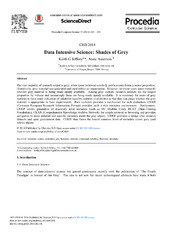Data Intensive Science: Shades of Grey
Peer reviewed, Journal article
Published version
Permanent lenke
https://hdl.handle.net/1956/10094Utgivelsesdato
2014Metadata
Vis full innførselSamlinger
Originalversjon
https://doi.org/10.1016/j.procs.2014.06.036Sammendrag
The vast majority of research output is grey; white (peer reviewed scholarly publications) forms a minor proportion. Historically, grey material was generated and used within an organisation. However, in recent years some research- relevant grey material is being made openly available. Among grey outputs, research datasets are the largest proportion by volume and increasingly these are being made openly available. It is necessary for users of grey material to have some indication of reliability (quality, context, availability) so that they can judge whether the grey material is appropriate to their requirements. Rich metadata provides a mechanism for such evaluation. CERIF (Common European Research Information Format) provides such a rich metadata environment. Furthermore, CERIF allows generation of discovery level metadata (such as DC (Dublin Core), DCAT (Data Catalog Vocabulary), CKAN (Comprehensive Knowledge Archive Network) for simple retrieval or browsing and provides navigation to more detailed and specific metadata about the grey object. CERIF provides a bridge over research datasets and open government data. CERIF thus forms the lowest common level of metadata across grey (and white) objects.

